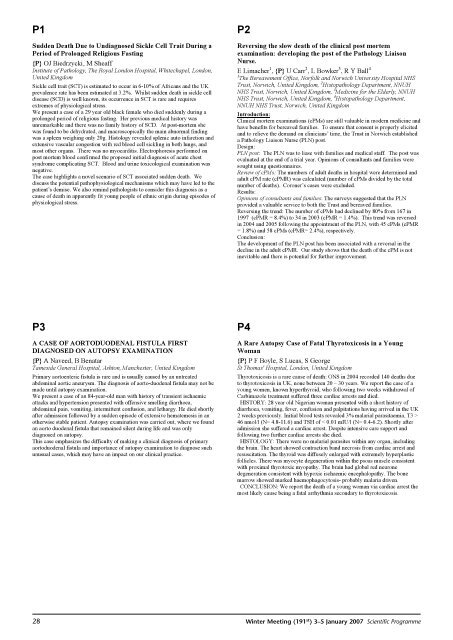2007 Winter Meeting - London - The Pathological Society of Great ...
2007 Winter Meeting - London - The Pathological Society of Great ...
2007 Winter Meeting - London - The Pathological Society of Great ...
- No tags were found...
You also want an ePaper? Increase the reach of your titles
YUMPU automatically turns print PDFs into web optimized ePapers that Google loves.
P1Sudden Death Due to Undiagnosed Sickle Cell Trait During aPeriod <strong>of</strong> Prolonged Religious Fasting{P} OJ Biedrzycki, M SheaffInstitute <strong>of</strong> Pathology, <strong>The</strong> Royal <strong>London</strong> Hospital, Whitechapel, <strong>London</strong>,United KingdomSickle cell trait (SCT) is estimated to occur in 6-10% <strong>of</strong> Africans and the UKprevalence rate has been estimated at 3.2%. Whilst sudden death in sickle celldisease (SCD) is well known, its occurrence in SCT is rare and requiresextremes <strong>of</strong> physiological stress.We present a case <strong>of</strong> a 29 year old black female who died suddenly during aprolonged period <strong>of</strong> religious fasting. Her previous medical history wasunremarkable and there was no family history <strong>of</strong> SCD. At post-mortem shewas found to be dehydrated, and macroscopically the main abnormal findingwas a spleen weighing only 20g. Histology revealed splenic auto infarction andextensive vascular congestion with red blood cell sickling in both lungs, andmost other organs. <strong>The</strong>re was no myocarditis. Electrophoresis performed onpost mortem blood confirmed the proposed initial diagnosis <strong>of</strong> acute chestsyndrome complicating SCT. Blood and urine toxicological examination wasnegative.<strong>The</strong> case highlights a novel scenario <strong>of</strong> SCT associated sudden death. Wediscuss the potential pathophysiological mechanisms which may have led to thepatient’s demise. We also remind pathologists to consider this diagnosis as acause <strong>of</strong> death in apparently fit young people <strong>of</strong> ethnic origin during episodes <strong>of</strong>physiological stress.P2Reversing the slow death <strong>of</strong> the clinical post mortemexamination: developing the post <strong>of</strong> the Pathology LiaisonNurse.E Limacher 1 , {P} U Carr 2 ,LBowker 3 ,RYBall 41 <strong>The</strong> Bereavement Office, Norfolk and Norwich University Hospital NHSTrust, Norwich, United Kingdom, 2 Histopathology Department, NNUHNHS Trust, Norwich, United Kingdom, 3 Medicine for the Elderly, NNUHNHS Trust, Norwich, United Kingdom, 4 Histopathology Department,NNUH NHS Trust, Norwich, United KingdomIntroduction:Clinical mortem examinations (cPMs) are still valuable in modern medicine andhave benefits for bereaved families. To ensure that consent is properly elicitedand to relieve the demand on clinicians’ time, the Trust in Norwich establisheda Pathology Liaison Nurse (PLN) post.Design:PLN post: <strong>The</strong> PLN was to liase with families and medical staff. <strong>The</strong> post wasevaluated at the end <strong>of</strong> a trial year. Opinions <strong>of</strong> consultants and families weresought using questionnaires.Review <strong>of</strong> cPMs: <strong>The</strong> numbers <strong>of</strong> adult deaths in hospital were determined andadult cPM rate (cPMR) was calculated (number <strong>of</strong> cPMs divided by the totalnumber <strong>of</strong> deaths). Coroner’s cases were excluded.Results:Opinions <strong>of</strong> consultants and families: <strong>The</strong> surveys suggested that the PLNprovided a valuable service to both the Trust and bereaved families.Reversing the trend: <strong>The</strong> number <strong>of</strong> cPMs had declined by 80% from 167 in1997 (cPMR = 8.4%) to 34 in 2003 (cPMR = 1.4%). This trend was reversedin 2004 and 2005 following the appointment <strong>of</strong> the PLN, with 45 cPMs (cPMR= 1.8%) and 58 cPMs (cPMR= 2.4%), respectively.Conclusion:<strong>The</strong> development <strong>of</strong> the PLN post has been associated with a reversal in thedecline in the adult cPMR. Our study shows that the death <strong>of</strong> the cPM is notinevitable and there is potential for further improvement.P3A CASE OF AORTODUODENAL FISTULA FIRSTDIAGNOSED ON AUTOPSY EXAMINATION{P} A Naveed, B BenatarTameside General Hospital, Ashton, Manchester, United KingdomPrimary aortoenteric fistula is rare and is usually caused by an untreatedabdominal aortic aneurysm. <strong>The</strong> diagnosis <strong>of</strong> aorto-duodenal fistula may not bemade until autopsy examination.We present a case <strong>of</strong> an 84-year-old man with history <strong>of</strong> transient ischaemicattacks and hypertension presented with <strong>of</strong>fensive smelling diarrhoea,abdominal pain, vomiting, intermittent confusion, and lethargy. He died shortlyafter admission followed by a sudden episode <strong>of</strong> extensive hematemesis in anotherwise stable patient. Autopsy examination was carried out, where we foundan aorto duodenal fistula that remained silent during life and was onlydiagnosed on autopsy.This case emphasizes the difficulty <strong>of</strong> making a clinical diagnosis <strong>of</strong> primaryaortoduodenal fistula and importance <strong>of</strong> autopsy examination to diagnose suchunusual cases, which may have an impact on our clinical practice.P4A Rare Autopsy Case <strong>of</strong> Fatal Thyrotoxicosis in a YoungWoman{P} P F Boyle, S Lucas, S GeorgeSt Thomas' Hospital, <strong>London</strong>, United KingdomThyrotoxicosis is a rare cause <strong>of</strong> death: ONS in 2004 recorded 140 deaths dueto thyrotoxicosis in UK, none between 20 – 30 years. We report the case <strong>of</strong> ayoung women, known hyperthyroid, who following two weeks withdrawal <strong>of</strong>Carbimazole treatment suffered three cardiac arrests and died.HISTORY: 28 year old Nigerian woman presented with a short history <strong>of</strong>diarrhoea, vomiting, fever, confusion and palpitations having arrived in the UK2 weeks previously. Initial blood tests revealed 3% malarial parasitaemia, T3 >46 nmol/l (N= 4.8-11.6) and TSH <strong>of</strong> < 0.01 mIU/l (N= 0.4-6.2). Shortly afteradmission she suffered a cardiac arrest. Despite intensive care support andfollowing two further cardiac arrests she died.HISTOLOGY: <strong>The</strong>re were no malarial parasites within any organ, includingthe brain. <strong>The</strong> heart showed contraction band necrosis from cardiac arrest andresuscitation. <strong>The</strong> thyroid was diffusely enlarged with extremely hyperplasticfollicles. <strong>The</strong>re was myocyte degeneration within the psoas muscle consistentwith proximal thyrotoxic myopathy. <strong>The</strong> brain had global red neuronedegeneration consistent with hypoxic ischaemic encephalopathy. <strong>The</strong> bonemarrow showed marked haemophagocytosis- probably malaria driven.CONCLUSION: We report the death <strong>of</strong> a young woman via cardiac arrest themost likely cause being a fatal arrhythmia secondary to thyrotoxicosis.28 <strong>Winter</strong> <strong>Meeting</strong> (191 st ) 3–5 January <strong>2007</strong> Scientific Programme













